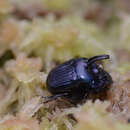pt-BR
nomes no trilho de navegação


Oxysternon is a genus of Scarabaeidae or scarab beetles in the superfamily Scarabaeoidea. It can be distinguished from all other phanaeines and scarabaeine dung beetles by a long, spiniform extension of the anterior angle of the metasternum. Most taxa vary in color and color pattern, and are more commonly found in tones of green, often infused with yellow or coppery highlights. All species appear very smooth or glassy smooth to the unaided eye.[1]
The genus Sternaspis was proposed first by Hope in 1837, but the name was preoccupied and thus invalid. Laporte, writing under the pen name of Le Compte de Castelnau, proposed the genus Oxysternon to include several species of Phaneus-like species. O. festivum was later designated as the type species.[2][1]
The genus is monophyletic and its sister group is the genus Phanaeus. Two subgenera and two further species groups are recognized by some authors. It has been suggested that the current distribution of the species reflect vicariance events following climatic fluctuations in the Amazon.[1]
There are currently 11 species in the genus Oxysternon.[3]
Oxysternon is a neotropical genus occurring north of the Tropic of Capricorn and east of the Andes. Only two, widespread species are found in the northwest of South America and up to the southern portion of Central America. Most Oxysternon species have restricted distributions within the Amazon basin, the Guiana Shield, the Cerrado region and the Atlantic coastal forest of Brazil.[1]
Oxysternon palaemon is a common beetle in the cerrado formations of Brazil and adjacent areas of Bolivia and Paraguay. All other species inhabit supermoist to mesic forest habitats with different degrees of tolerance to fragmentation and forest degradation.[1][5]
The behavior of Oxysternon species has not been studied in detail. All species seem to be coprophagous or copro-necrophagous, although fruit pulp is sometimes used as an adult food resource.[6]
Oxysternon is a genus of Scarabaeidae or scarab beetles in the superfamily Scarabaeoidea. It can be distinguished from all other phanaeines and scarabaeine dung beetles by a long, spiniform extension of the anterior angle of the metasternum. Most taxa vary in color and color pattern, and are more commonly found in tones of green, often infused with yellow or coppery highlights. All species appear very smooth or glassy smooth to the unaided eye.
Oxysternon est un genre de scarabées de la sous-famille des Scarabaeinae.
Oxysternon est un genre de scarabées de la sous-famille des Scarabaeinae.
Oxysternon er en slekt av biller som hører til familien skarabider (Scarabaeidae). Disse billene har larver som utvikler seg i møkk som de graver ned.
Stort sett middelsstore (gjerne 20-25 millimeter), høyt hvelvede, korte og kraftige gjødselbiller. Mange har friske metalliske farger, andre er svarte. Denne slekten omfatter noen særlig fargerike arter. Spesielt hannene har gjerne horn og utvekster av ulike slag på hodet og pronotum, noe som gjør denne gruppen til ganske spektakulære insekter. Ofte har hannen et langt, krumt horn i pannen. Pronotum er mye bredere enn langt. Dekkvingene er korte og brede med dype lengdefurer. Beina er kraftige gravebein.
Disse billene ruller møkk sammen til baller og graver dem ned, ofte ganske dypt, i bakken. Hannen og hunnen samarbeider om dette, men når gangen er ferdig og etter at de har parret seg, flyr hannen bort mens hunnen blir igjen i gangen for å ta seg av larvene som etter hvert klekkes. Hun holder møkkballene frie for rovdyr og uønsket soppvekst til larvene er fullvoksne, noe som gjerne tar flere måneder.
Gruppen er utbredt i Mellom- og Sør-Amerika.
Oxysternon er en slekt av biller som hører til familien skarabider (Scarabaeidae). Disse billene har larver som utvikler seg i møkk som de graver ned.